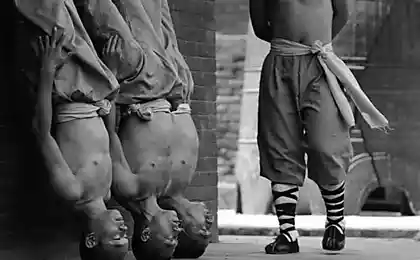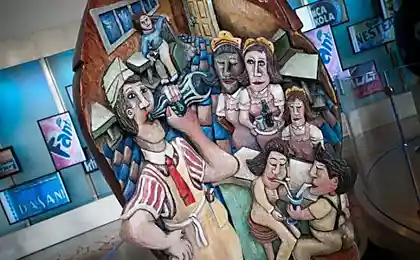1901
Myths and Legends of Shaolin
By combining the controversial history of Buddhist warriors and a major military history of China, Shaolin monks have got an incredibly fascinating legends originating from the founding of the empire in about 496 AD. Here are the 10 most impressive:

1. Many of the techniques of combat equipment borrowed from Indian animals
There is a legend that once came to the Shaolin Temple monks and showed people fighting techniques that he spied in animals.
However, historians believe that in fact the tradition of Shaolin appeared somewhat less mystical way. This organization originated as a private army and military equipment were formed within the group itself. Of course, not so good to know that the monks of Shaolin - heirs of the group of mercenaries, who later became a religious way, however, this assumption is a little more reasonable and believable.
2. How the thirteen monks saved the Emperor
One of the earliest legends tells about events that happened around the year 621.
Emperor Tang Teyzong rebels tried to seize the city, came when another rebel army, numbering 300 thousand people. He asked for help from the Shaolin and received assistance only thirteen soldiers.
They were instructed to make a decisive attack at a key moment following the battle, and they really saved the army from destruction. However, the scene in which thirteen soldiers defeat an army of hundreds of thousands of soldiers - it's something out of science fiction.
3. Training maze trap or "Shaolin Wooden Men"
The severity of training in Shaolin has acquired many legends, especially the final test.
There is, for example, the myth of the labyrinth of wooden dolls on which was to be held each student. We had to wade through a revolving wooden mannequin sticking out at different heights bars of different lengths. It was necessary to use all sorts of fighting techniques.
Such mannequins in a maze, there were 36, and they were equipped with deadly blades. One wrong move could cost the life of a disciple.
4. God hates Vaprapni intimidation and vegetarianism
Vaprapni - honored Shaolin Indian god of war and the protagonist of the story, which came to us from the seventh century.
Once there lived a monk named Shengchou. In the monastery, he was a target for izdёvok. Six days later, he asked for help from God Vaprapni. God appeared to him and forced him to commit the forbidden act at the Shaolin monks - to eat a piece of meat.
The award Shengchou got tremendous power and get even with offenders, forcing them to beg for mercy.
Curiously enough, from among the legends of the Shaolin monk appeared on history, breaking the vow for the sake of petty self-interest and received a generous reward.
5. The feat Ji Nau Lowe
In the middle of the sixth century, the monks of Shaolin have had to deal with a group of rebels who called themselves "red turbans».
Once these "turbans" lured the bulk of monks from the monastery and attacked the temple, which remained a handful of the most prominent fighters do not. One of the remaining cook Ji Nau was Lowe, who secretly studied the martial arts of Shaolin.
He grabbed a huge log burning, and draw the enemy to flight, using a simple combat techniques. In some versions of this story it states that the chef was a giant. However, it bears little resemblance to the truth.
6. Unusual way to join the monks
There is another legend of the sixth century, which is impressive, but exactly the opposite reason. Indian prince named Bodhidharma, being in China, hated the government, which was the Shaolin Temple and did not hide it.
After predictable alienation and misunderstanding, he went to a nearby cave and began to meditate. Some legends say that it lasted nine lunar cycles, while others claim that all nine years.
Whatever it was, it is so impressed with the monastery, he was not only allowed to stay, but also provide your own room at the time, perhaps, the cave has become home to him.
7. Original disappearance
In the mid-16th century to protect the inhabitants of the monastery called on China from the raids of Japanese pirates. 120 Shaolin warriors fought the Japanese in the four battles, armed with 35-pound sticks, and in each of the first three battles perished not more than four persons. The fourth battle killed nearly all left three soldiers. According to legend, the three night bury themselves with the help of cane and crawled under the ground. Even I wonder who could come up with such.
8. How to leave the monastery
Leaving the monastery was no easy matter. However, they say, it has been one way: three monks who want to leave the monastery, were to unite and fight with eighteen other monks. The three had to have very good skills of fighting to win.
In fact, this could hardly avoid, because it would mean that the monastery is deprived of the three best fighters and eighteen losers would feel offended.
However, the re-enactment of the myth is part of today's performances of Shaolin monks.
9. The countries of origin of tea bushes
This story is related to the event, which was mentioned in the sixth myth, but it deserves a separate story.
As you remember, the Indian prince spent nine years meditating in a cave. Obviously, it was very heavy for nine years, since the seventh year, he just fell asleep.
To this does not happen again, he cut off his eyelids. When his eyelids fell to the ground, they turned into the tea bushes - so nature rewarded his sacrifice.
In real life, the prince just lost to view. Perhaps the purpose of this "unappetizing" legend was that to discourage monks desire to engage in the supply of tea.
10. The needle through the glass
The most famous myth of Shaolin heritage is this video, in which the monk throwing a needle, and it passes through the glass, as if his hand has turned the needle into the bullet. This myth has been refuted "Mythbusters." Though, whether all can be checked with the help of technology?
However, fans of Shaolin claim that gimmick, shown in the video, we need a stronger needle and a thin glass. But whatever the truth, you see, this video I want to show friends!
Source Your text to link ...

1. Many of the techniques of combat equipment borrowed from Indian animals
There is a legend that once came to the Shaolin Temple monks and showed people fighting techniques that he spied in animals.
However, historians believe that in fact the tradition of Shaolin appeared somewhat less mystical way. This organization originated as a private army and military equipment were formed within the group itself. Of course, not so good to know that the monks of Shaolin - heirs of the group of mercenaries, who later became a religious way, however, this assumption is a little more reasonable and believable.
2. How the thirteen monks saved the Emperor
One of the earliest legends tells about events that happened around the year 621.
Emperor Tang Teyzong rebels tried to seize the city, came when another rebel army, numbering 300 thousand people. He asked for help from the Shaolin and received assistance only thirteen soldiers.
They were instructed to make a decisive attack at a key moment following the battle, and they really saved the army from destruction. However, the scene in which thirteen soldiers defeat an army of hundreds of thousands of soldiers - it's something out of science fiction.
3. Training maze trap or "Shaolin Wooden Men"
The severity of training in Shaolin has acquired many legends, especially the final test.
There is, for example, the myth of the labyrinth of wooden dolls on which was to be held each student. We had to wade through a revolving wooden mannequin sticking out at different heights bars of different lengths. It was necessary to use all sorts of fighting techniques.
Such mannequins in a maze, there were 36, and they were equipped with deadly blades. One wrong move could cost the life of a disciple.
4. God hates Vaprapni intimidation and vegetarianism
Vaprapni - honored Shaolin Indian god of war and the protagonist of the story, which came to us from the seventh century.
Once there lived a monk named Shengchou. In the monastery, he was a target for izdёvok. Six days later, he asked for help from God Vaprapni. God appeared to him and forced him to commit the forbidden act at the Shaolin monks - to eat a piece of meat.
The award Shengchou got tremendous power and get even with offenders, forcing them to beg for mercy.
Curiously enough, from among the legends of the Shaolin monk appeared on history, breaking the vow for the sake of petty self-interest and received a generous reward.
5. The feat Ji Nau Lowe
In the middle of the sixth century, the monks of Shaolin have had to deal with a group of rebels who called themselves "red turbans».
Once these "turbans" lured the bulk of monks from the monastery and attacked the temple, which remained a handful of the most prominent fighters do not. One of the remaining cook Ji Nau was Lowe, who secretly studied the martial arts of Shaolin.
He grabbed a huge log burning, and draw the enemy to flight, using a simple combat techniques. In some versions of this story it states that the chef was a giant. However, it bears little resemblance to the truth.
6. Unusual way to join the monks
There is another legend of the sixth century, which is impressive, but exactly the opposite reason. Indian prince named Bodhidharma, being in China, hated the government, which was the Shaolin Temple and did not hide it.
After predictable alienation and misunderstanding, he went to a nearby cave and began to meditate. Some legends say that it lasted nine lunar cycles, while others claim that all nine years.
Whatever it was, it is so impressed with the monastery, he was not only allowed to stay, but also provide your own room at the time, perhaps, the cave has become home to him.
7. Original disappearance
In the mid-16th century to protect the inhabitants of the monastery called on China from the raids of Japanese pirates. 120 Shaolin warriors fought the Japanese in the four battles, armed with 35-pound sticks, and in each of the first three battles perished not more than four persons. The fourth battle killed nearly all left three soldiers. According to legend, the three night bury themselves with the help of cane and crawled under the ground. Even I wonder who could come up with such.
8. How to leave the monastery
Leaving the monastery was no easy matter. However, they say, it has been one way: three monks who want to leave the monastery, were to unite and fight with eighteen other monks. The three had to have very good skills of fighting to win.
In fact, this could hardly avoid, because it would mean that the monastery is deprived of the three best fighters and eighteen losers would feel offended.
However, the re-enactment of the myth is part of today's performances of Shaolin monks.
9. The countries of origin of tea bushes
This story is related to the event, which was mentioned in the sixth myth, but it deserves a separate story.
As you remember, the Indian prince spent nine years meditating in a cave. Obviously, it was very heavy for nine years, since the seventh year, he just fell asleep.
To this does not happen again, he cut off his eyelids. When his eyelids fell to the ground, they turned into the tea bushes - so nature rewarded his sacrifice.
In real life, the prince just lost to view. Perhaps the purpose of this "unappetizing" legend was that to discourage monks desire to engage in the supply of tea.
10. The needle through the glass
The most famous myth of Shaolin heritage is this video, in which the monk throwing a needle, and it passes through the glass, as if his hand has turned the needle into the bullet. This myth has been refuted "Mythbusters." Though, whether all can be checked with the help of technology?
However, fans of Shaolin claim that gimmick, shown in the video, we need a stronger needle and a thin glass. But whatever the truth, you see, this video I want to show friends!
Source Your text to link ...






















